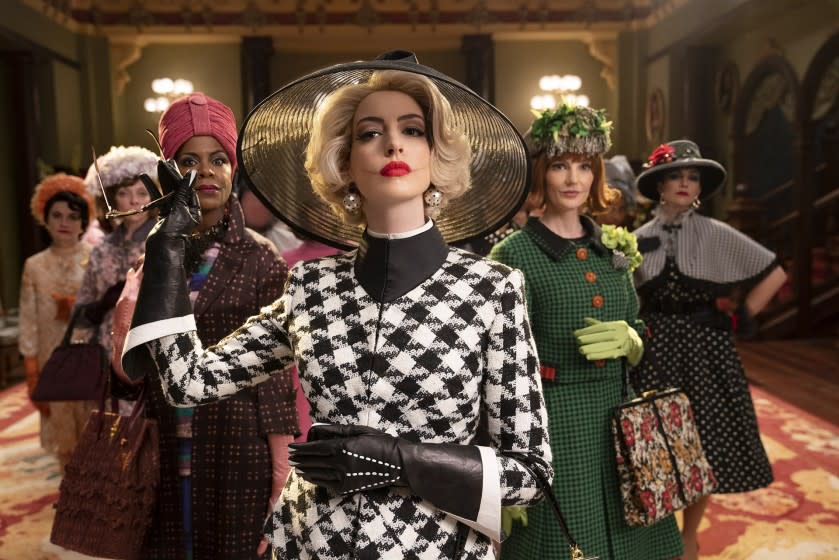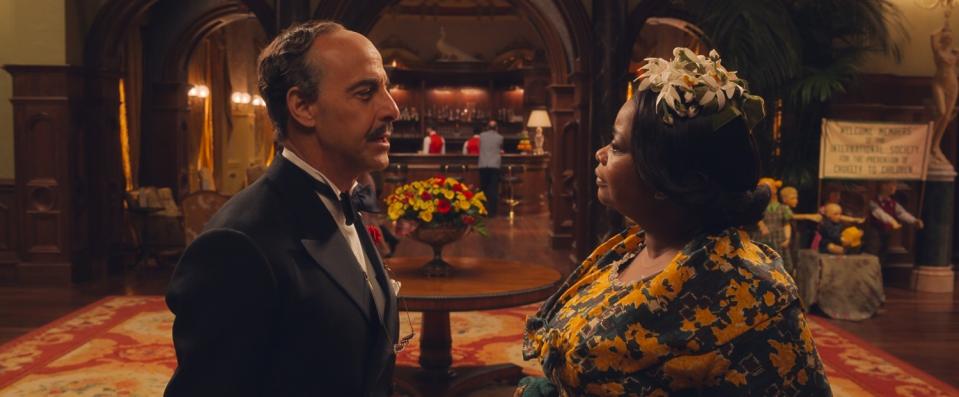Remaking 'The Witches' for 2020: How the HBO Max film updates Roald Dahl's classic story

- Oops!Something went wrong.Please try again later.
Roald Dahl’s 1983 novel “The Witches” has always been an especially terrifying children’s story. But even as Dahl's tale continues to scare and delight readers today, the fantasy novel can also feel dated, which is what led director Robert Zemeckis to deliver a new cinematic take.
In Zemeckis' “The Witches,” which is now streaming on HBO Max, the setting shifts from Europe to rural Alabama in 1968, and the cast gets a more inclusive twist.
The Oscar-winning director came onboard after Warner Bros first developed the project with Guillermo del Toro, who wrote the initial version of the script (still set in Europe). Zemeckis took a second pass at the script with "black-ish" creator Kenya Barris as his co-writer. Diversity wasn’t the main aim, but an added benefit.
The pair wanted to expand the original story and “present a different type of culture,” according to Zemeckis, who adds, “These stories take places in all cultures.” The film’s grandma (Octavia Spencer) and young hero (Jahzir Bruno) are now Black, an idea that came up early in the process.
“It’s a timeless story and it can easily be updated,” Zemeckis says. “The South is kind of Gothic and it has a tradition of witchcraft and voodoo and strange things going on. It was pretty natural to set it there. Changing the [race of the] lead characters was the main idea I had when Warner Bros asked me if I wanted to do an update of it. I said, ‘Yeah, but it would a good idea and a fun idea to make the hero boy African American.’ It’s kind of funny as a filmmaker to talk about how my movies look like the world.”
For the cast, the pairing of Dahl and Zemeckis was the main draw, but both Anne Hathaway, who stepped into the shoes of the Grand High Witch, and Spencer were also intrigued by the updates.
“There’s a lot of questions about why we make things, particularly when really wonderful films exist, and I think increasing representation in classic stories is a fantastic reason to remake a film,” says Hathaway, speaking on the film’s set last summer in London. “And I think the film winds up making a quiet social statement about the way we value — or don’t value — children of different levels of means.”

“I’m from Montgomery, Ala., and [the story] is set in Demopolis, so it spoke to me,” Spencer adds. “I don’t want to act as if I wasn’t a little surprised by the changes, but it just feels as if it’s a natural progression of things right now — to try a different spin on things.”
The 1990 film, produced by Jim Henson Productions, used elaborate prosthetics and practical effects for the witches, as well as puppets and actual mice for the transformed children. While some actual prosthetics were used for Hathaway’s Grand High Witch during filming on the new version, Zemeckis and his team wanted to take advantage of the VFX technology currently available. Much of the witches’ aesthetic came to life during post-production, particularly their wide, toothy grins, inspired by a so-called Chelsea smile.
“[We wanted] to bring the witches to life in a way that is new and unique,” notes visual effects supervisor Kevin Baille. “He didn’t want to do the classic witch who had a deformed face and long nose with hairy warts. He wanted the witches to be elegant. They hide in plain sight, so there’s not a mask they pull off. Behind closed doors, when they come out of hiding, these scars on their cheeks turn into an ear-to-ear grin.”
“I’m trying to witch-ify them using modern digital makeup rather than putting rubber prosthetics on them," Zemeckis adds. "I wanted to keep a lot of the elements that are in the book. They’re bald, they have no toes, they have claws. But then we thought it would be more interesting if they were walking around in some kind of Hitchcock glamour. If you were a witch and you could kill people and you could conjure things and you could steal things, why wouldn’t you want to wear high fashion?”
Costume designer Joanna Johnston designed looks for 50 witches in total, some of them reflecting that sort of vintage glamour and some a bit more grotesque. Their clothes and color palettes reflect their global backgrounds (you’ll immediately notice the Irish witch), and Johnston felt like she didn’t need to be faithful to any sort of historical accuracy in a fantasy story.
“I decided witches go on their own passage of whatever they want to do, so there’s a foothold in 1968 and then a foothold in anywhere,” she notes. “You can go so many different directions with them, but I wanted to make it as witty as possible and weird. I wanted to do things that felt cult-ish. It’s a combination between style and amusement ... In my backstory, there are witches who live in wooden huts in the forest and then there are witches who live in fashionable metropolises.”

To complete the looks, makeup and hair designer Peter King needed over 130 real-hair wigs, with a double for every character and several for Hathaway. A few of the actresses shaved their heads, while the rest wore bald caps for the scene when the witches let their authentic selves be seen.
“They had to be shop wigs because that’s what they would wear,” King says. “They’ve had some of them for a long time and some are very grand, like big bouffant. It’s been really good fun. It’s nice to do something period, but it’s also fun because they take them off and they’re all bald underneath.”
For Hathaway, who based the Grand High Witch’s accent on Old Norse, it was important to give her character a backstory beyond what was in the script. Her character is ruthless and evil, but she also needed to be enjoyable for the audience.
“With everything I always look at what’s on the page and then I imagine who they are off the page,” Hathaway says. “I imagine she has this long-running, on again/off again affair with Satan. The first thing I did was start to imagine that when she’s not berating the witches she’s in her room calling Satan and literally burning up the phone lines.
"I got very into the idea that about 400 years ago this group of demons who look like women decided to steal the name witch from actual witches who were doing really cool things. So they started to do all these nasty things, let real witches get blamed for them, let all the real witches get killed and took over.”
For Hathaway, this version of “The Witches” retains what made the original story so magical in the first place. The setting and the characters may be updated for a new generation, with modern technology instrumental in creating the visuals, but in the end it’s a story about being yourself and finding magic in your relationships, no matter who you are.
“I imagined parents and their children lying in bed together reading this doing the voices,” the actress says. “There’s nothing more magical as your parents reading to you, so you have to be as special as that in your own way. That’s part of the reason why it feels like we’re on a trampoline [while making this], because kids are less stingy with their willingness to escape.
"It has been my experience with modern movie audiences where in the beginning of my career people leaned forward, now people sit back. But kids are amazing. They’re on board for the weird moments. The goal is that we’ll make something that then adults will be happy they saw, too.”
This story originally appeared in Los Angeles Times.

